全球設計風向感謝來自 尌林建築設計事務所 的鄉村建築項目案例分享:
南邊多山,山有深林。
Mountains surround the house in the south, covered with thick forests.
∇ 群山環繞的村子 Village surrounded by hills

拾雲山房位於浙江省金華武義縣一處山林古村之中,村子保留了完整的夯土民居麵貌,村中建築依山勢高差而建,群山環繞,村口處尚存幾顆繁茂的古樹,已上百年。書屋坐落於村口廣場不遠處,旁邊是保留完好的夯土三合院民居,場地原址有一個牛欄房,坍塌後被拆除。
The house is located in an ancient mountain forest in Wuyi County, Jinhua, Zhejiang Province. The village maintains complete features from old inhabitants in this area, with buildings scatters in different altitudes by the mountain line and dense trees with history of over one hundred years at the entrance. The book house sits not far from the square at the entrance, beside which is well-preserved courtyard houses made in rammed earth. The old cowshed used to locate at the yard, but was removed after it collapsed.
∇ 村子全貌 Whole picture of the village

建造書屋,是為了給古村提供一個閱讀的空間,一個讓人靜下心的地方,從而吸引更多的年輕人和小孩子回到山裏;也希望能夠創造出一個豐富而安靜的場所,讓小孩子和老人都能在這座建築中裏感受到自由和快樂。
The book house aims to create a serene reading space that clams people down, thus attracting more young people and children to return to the mountains. It also provides a colorful and quiet place so that children and the elderly can feel freedom and happiness in this house.
∇ 俯瞰建築,融入周邊民居 Overlook of the building: fitting into the surroundings

∇ 鳥瞰書屋 Bird’s eye view of the book house

讓空間與鄉村友好
Bring the space and the village closer
把書屋的一部分空間留給村民,是我們設計初始階段就有的想法,也是一種直覺性的感受,在書屋的首層做一個架空的半室外開放空間,用十根結構柱架空整個書屋首層,實體空間都設定在二層,兩個空間通過一部室外樓梯進行連接,隻在首層局部設置了一個小水吧,可以提供水飲,其他的空間完全公共開放,山裏的村民們可以在此喝茶聊天,小孩們也可以在這個空間玩耍打鬧,用這個開放空間把各種活動的可能性都串聯起來。
One of our initial thoughts is to spare room for the villagers, which also brings an intuitive feeling. In the first floor of the book house, there is an overhead semi-outdoor open space, and ten structural columns hold the entire house. The closed spaces are on the second floor, connected to the outside with an out-door staircase. There is only a tiny water bar on the first floor for water and beverages, the other places are totally open for villagers to drink, chat and for kids to play. The open space connects all the possible activities.
∇ 書屋融合在村子環境中 Book house fits into the surroundings of the village

∇ 從西南角看架空的書屋 Off-contact book house from the southwest corner
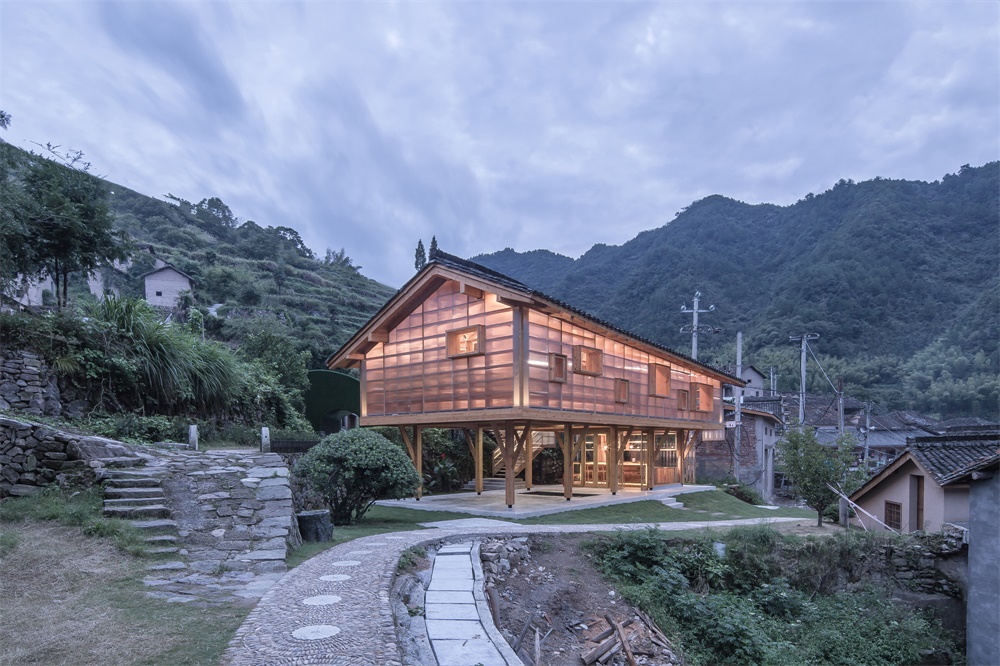
∇ 書屋西立麵 West façade of the book house
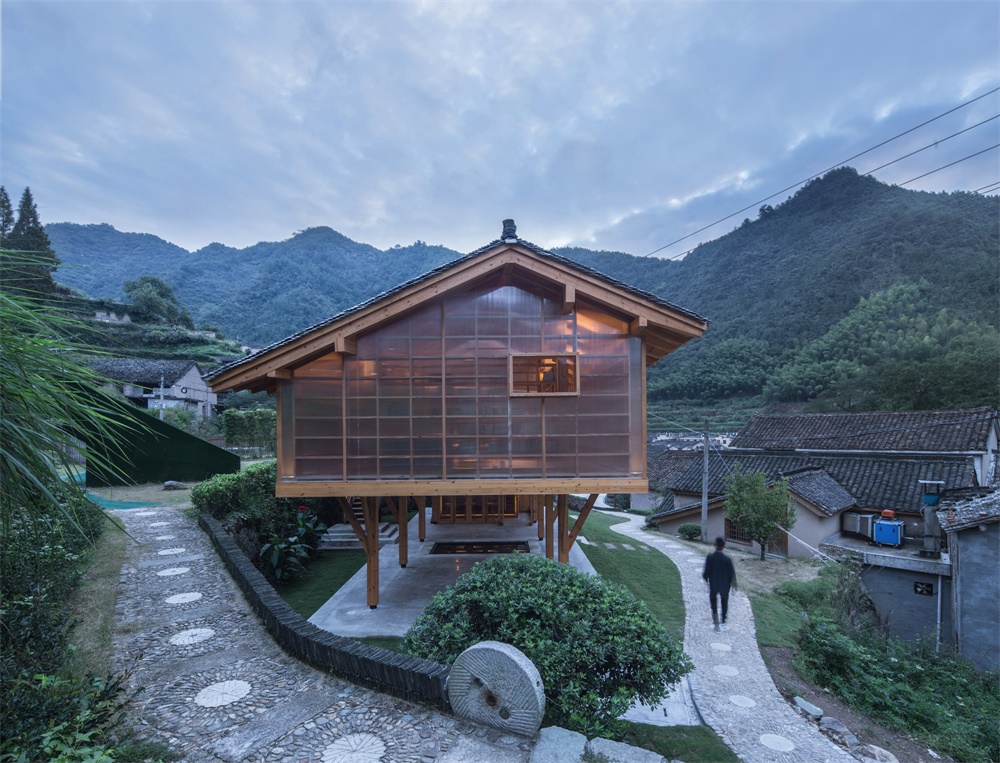
∇ 村民在書屋首層喝茶聊天場景 Villagers drinking tea and chatting on the top of the book house

同時站在場地關係的角度思考,書屋用地處於一個三角地帶,南側是該村落的主要步行幹道,北側有一堵三米高的石坎牆,石坎牆上麵是一片兒童戲玩區,在設計策略上抬高書屋的實體空間部分,讓建築體首層與道路之間形成空間的退讓,路上的行人也可以隨時到書屋下休息。而書屋的二層則和兒童戲玩區在同一空間層麵上,這樣的處理,一方麵便於兒童進入書屋看書或者在兒童區玩耍,另一方麵,方便父母在書屋裏閱讀的同時能關注到孩子。無論是站在場地屬性的角度還是站在對鄉村生活理解的角度,在鄉村設計建築,我們都希望建築與村民、與鄉村環境都能保持一種最友好的狀態。
At the same time, from the perspective of the space relationship, the book house is in a triangle area, with the main walkway on the south and a three-meter stone wall on the north. Above the wall there is playground for children. By lifting up the close space of the house to give room to the space between the ground floor and the walkway, passers-by are also made able to rest under the house at any time. The second floor is on the same level as the children’s play area, which makes it convenient for kids to read books or play while their parents can still pay attention to their children when reading. Whether it is from the perspective of the nature of the site or that of understanding rural life, we hope that architecture and villagers, as well as the rural environment, can remain friendly to each other.
∇ 書屋北立麵 North façade of the book house

∇ 建築與場地的高差處理 Height difference between the house and the place

∇ 書屋首層與村道的關係 First floor and the walkway

天井與時間性
Patio and time
天井作為空間核心被安放在書屋中,尺度怡人,在首層天井底部下方留出一片水麵,下雨時,雨水從天井落入書屋水池,在書屋就可以聽到滴滴答答的聲音;晴天時,陽光可以直接照射進來,形成獨特的光影效果。之所以在很小的書屋裏去營造一個天井,也是為了讓這個小房子能與自然、時間、空間產生更多的關聯性,這可能就是一種我所認為的時間性。
The patio is placed in the book house as the core with a pleasant scale. There is a surface of water below the bottom of the first-floor patio. At rainy days, water rain falls from the patio into the pool, and the sound can be heard inside the house; while when the sun shines directly, it creates a unique light and shadow effect. A patio is designed in such a small place because it makes the house more relevant to nature, time and space. This is a sense of time in the house from my perspective.
∇ 雲霧中的書屋 Book house in the clouds
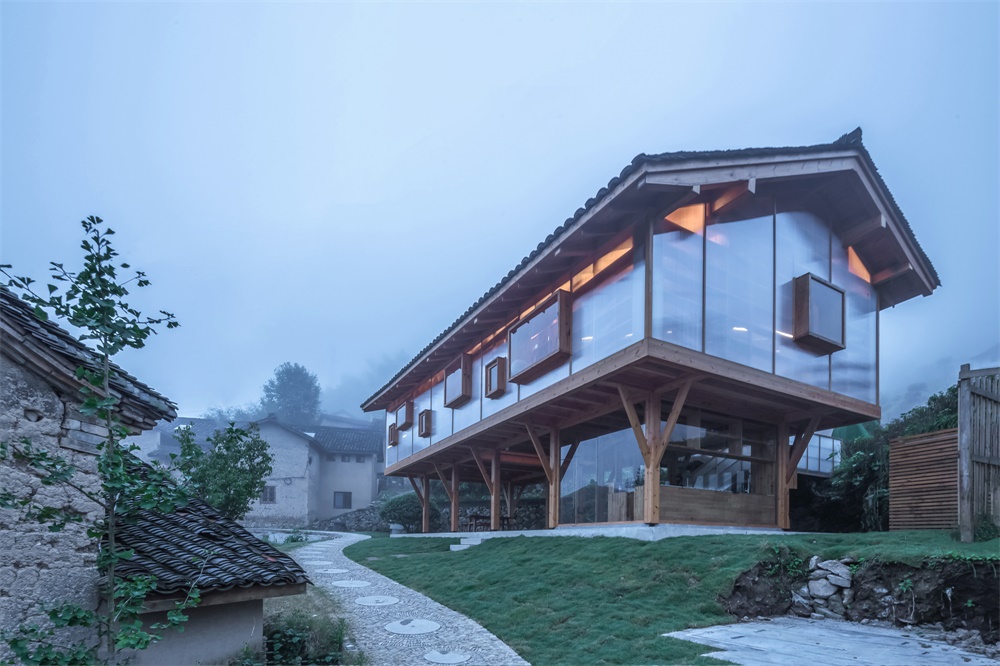
∇ 天井與水院 Patio and the water pool

∇ 雨水落入天井 Rain falling into the patio
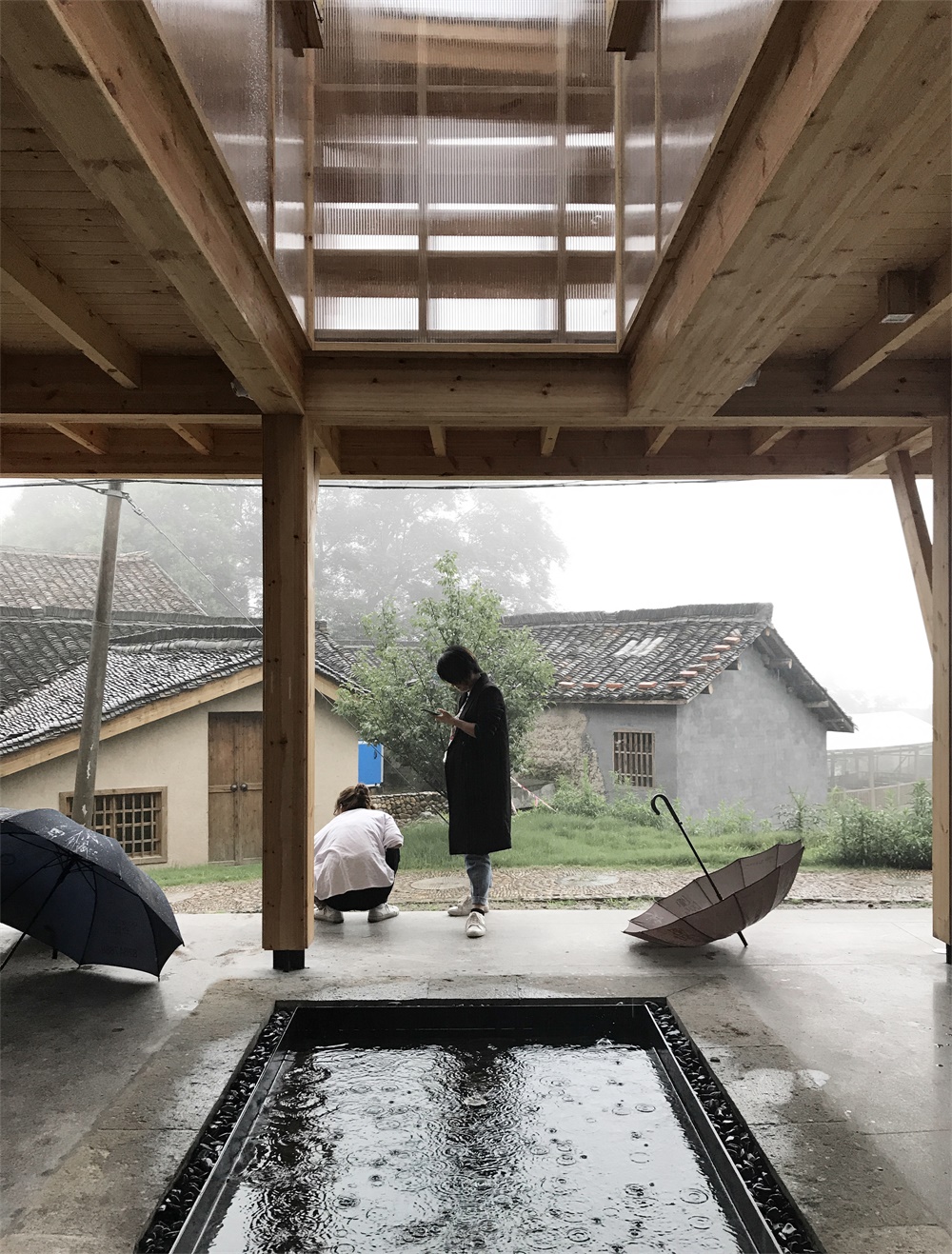
天井空間的設置,就是在等某個特定的時間——陽光灑進來,形成一道光影;雨水落入水院,產生一點漣漪;空氣流進來,感受一縷微風。在這樣的時刻,天井被設定為一個等待此時間點的特殊意義空間。我所理解的鄉村建築的精髓,是一種人與空間、人與自然、人與時間和諧共處的狀態。陽光、雨水、空氣都可以通過天井被納入室內空間。
The setting of the patio looks like it is waiting for a certain time – for the sun to cast in a beautiful shadow, for the rain to drip ripples, or for the breeze to blow in. At those moments, the patio is set as special space waiting for its significance of being created. The essence of rural architecture as I understand is a state in which people and space, people and nature, and people and time coexist harmoniously. This patio, makes it happen by including sunlight, rain and air into the interior space.
∇ 透過天井看到對麵的閱讀空間 Reading space from patio

∇ 柱腳局部細節 Details of column bottom

回廊與交流
Corridor and communication
在書屋二層設計了兩圈回字形的書架,書架圍繞天井和中間的閱讀空間形成一個回廊,一米左右的寬度,尺度舒服,由首層結構架空懸挑而出。通過這樣一個回廊,讓人遊走在其中,能產生類似園林遊走的體驗;同時,回字形書架上根據書架的模數尺寸,打開了很多洞口,它們高低錯落、大小不一,讓視線穿透,空氣流動。
There are two rounds of back-shaped bookshelves in the second floor, creating a corridor around the patio and the reading space in the middle. With a comfortable width of one meter, it suspends from the structure of the first floor. The corridor provides the experience of walking around in the garden, while a lot of holes are opened according to the modular size of the back-shaped bookshelves, letting the light and air flow through the difference of size and height.
∇ 入口與上夾層的樓梯 Staircase between the entrance and the upper floor
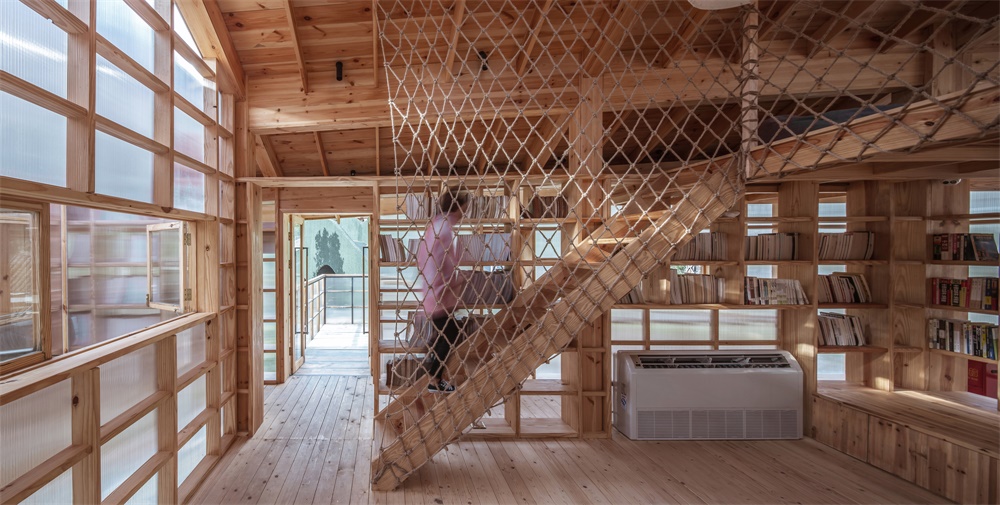
讀者漫遊於回廊時,視線和空間通過洞口突然被打開,空間的邊界便消隱了。當人站在洞口的另一邊,透過窗口,不但能看到坐在窗台上看書的人,還能看到更遠的窗外,遠處的山林和大樹。通過屋內層層遞進的透視感能產生空間與人,與環境的交流和對話。
As the reader wonders around in the corridor, their horizon opens together with the entrance, and the boundaries disappear. When standing on the other side of the entrance, people can see through the window and watch others reading books at the balcony, and farther, the hills and forests far away. The perspective from different layers creates the communication between people, space and the environment.
∇ 書架框內窺視閱讀空間 Peeking into the reading space inside the shelves
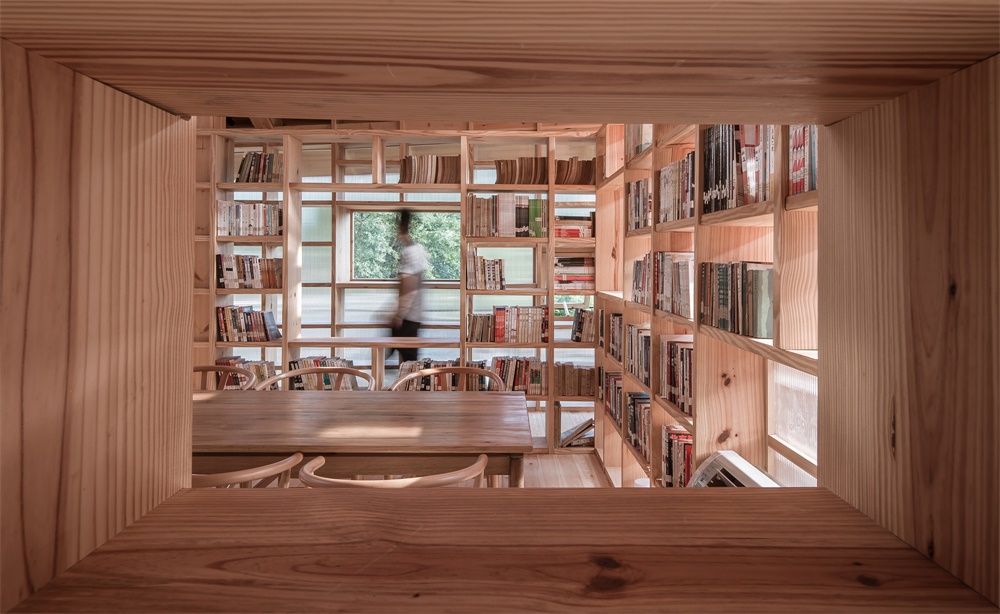
∇ 兒童閱讀空間的多種狀態 Multiple states of children’s reading space
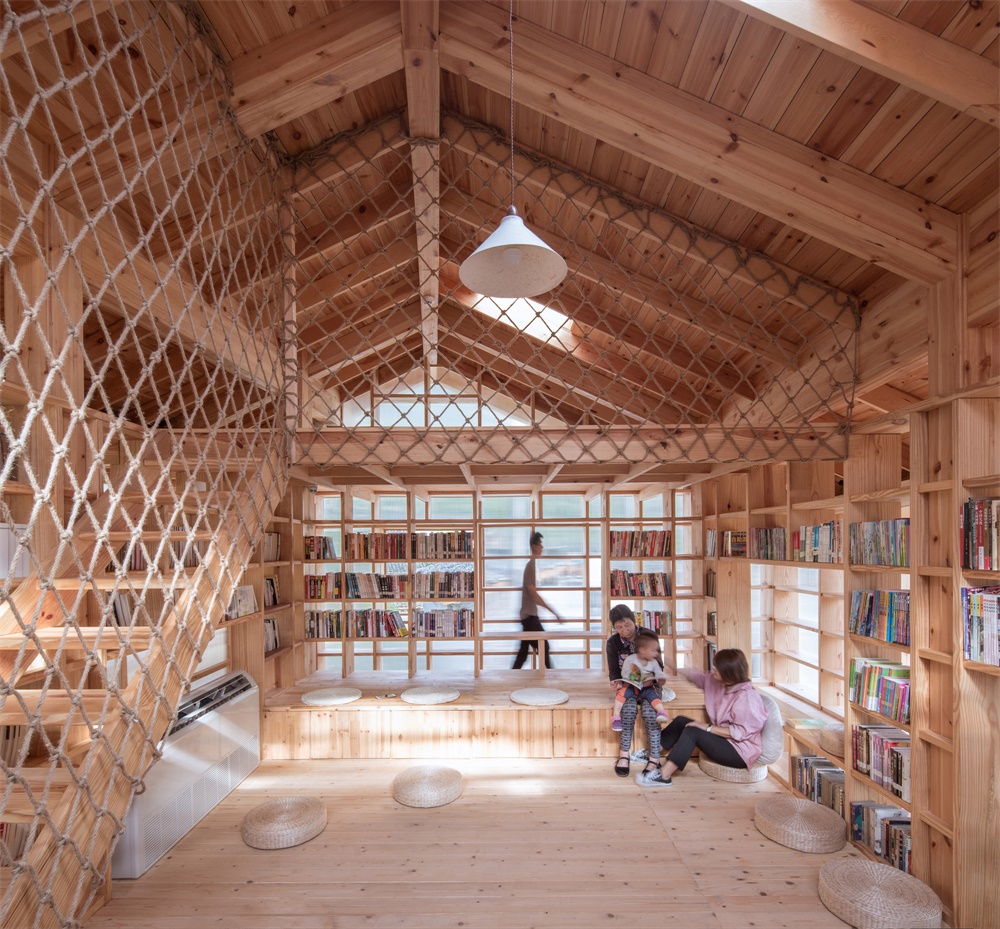
∇ 與閱讀狀態相結合的書架 Bookshelves relevant to reading status

∇ 通透的書架關係 Spatial connection of the bookshelves

實驗性的嚐試
Experimental attempt
實驗性是我們一直在堅持的建築設計研究方法,在書屋的設計中,我們做了兩個實驗,一個是形態類型上的實驗,一個是材料運用上的實驗。
We have always been insisting the design and research method of research. During the design of the book house, we made two experiments: the experiment on the morphological type, and the experiment on the application of materials.
∇ 書屋融合在層疊的屋頂關係裏 The book house integrated in stacked roof

∇ 形態演變 Morphological evolution

形態類型上,把書屋實體空間部分抬高,實體部分延續當地民居的雙坡屋頂形式和坡度,以及傳統的屋麵順水做法和小青瓦的鋪設,卻在屋頂的屋脊上做了微小的設計動作,讓屋脊的角度做了6.5°小偏轉。使書屋的屋頂形態發生一點微妙的形態變化,屋頂的簷口一高一低,室內屋頂的傾斜結合均質書架的空間,讓空間發生變化。
In terms of morphological type, the closed space of the book house is raised up, using the double-sloping roof form and slope of the local dwellings, as well as the traditional roofing and the grey tiles, but small adjustments was made on the roof ridge. It is deflected by 6.5°bringing a subtle morphological change to the roof, making the one side of the roof higher than the other, and enabling the space to change through the inclination of roof and the shelves.
∇ 書架對應的屋頂結構關係 Relation between the shelves and the roof

材料運用上,書屋的書架選擇3公分厚的鬆木板模數化布置,用統一的模數尺度語言控製,書架的豎檔和屋頂的結構梁用材一一對應,形成整體的語言邏輯體係。在外立麵上,采用鄉村比較少見的陽光板,讓整個房子變成了一種半透明的狀態,室內的光線透過陽光板變得很溫和,給書屋室內形成一種舒適的閱讀環境,同時,半透明的材料可讓室內的人對室外景觀有一種若隱若現的朦朧美,實現一種半通透性的空間感受和氛圍的目的。
In terms of materials, the bookcases use the modular structure of there-centimeter thick pine wood, and is controlled by a unified modular scale language. The vertical frame of the bookshelf and the structural beam of the roof are in one-to-one correspondence, forming an overall language logic system. On the outer façade, the relatively rare sun panels in the village make the whole house translucent, and the light in the room becomes gentle through the sun panels, creating a comfortable environment for reading. The translucent material allows readers inside to have a glimpse of the outdoor landscape, achieving a semi-transparent spatial experience and atmosphere.
∇ 溫和的光閱讀環境 Reading room with gentle light

∇ 若隱若現的室外景觀 Looming outdoor landscape

鄉村對於很多建築師來說是一個陌生的領域,很多建築師也逐漸參與到鄉村中不斷做嚐試。我們也是一樣,抱著探索和融合的心態,以建築師的身份嚐試介入鄉村,很多時候,設計的靈感不僅隻來自建築師的直覺判斷,而且需要根植於鄉村本身,讓在地性與創造性很好的結合。其實鄉村沒有標準,沒有固定法則,沒有唯一性,好壞隻能讓鄉村自身來判斷,我希望這會是一個好的開始。
Many architects are unfamiliar with the countryside, but they also make attempts to design. We are the same. We are the same. With the hope of exploration and integration, we try to intervene in the countryside as architects. In many cases, the inspiration not only comes from the intuitive judgment of the architect, but is also rooted in the countryside itself, so that the locality and creativity can connect well. In fact, there are no standards for the countryside, no fixed rules, no uniqueness, and good or bad can only be judged by the village itself. I hope this will be a good start.
∇ 傍晚的書屋 Book house in the evening
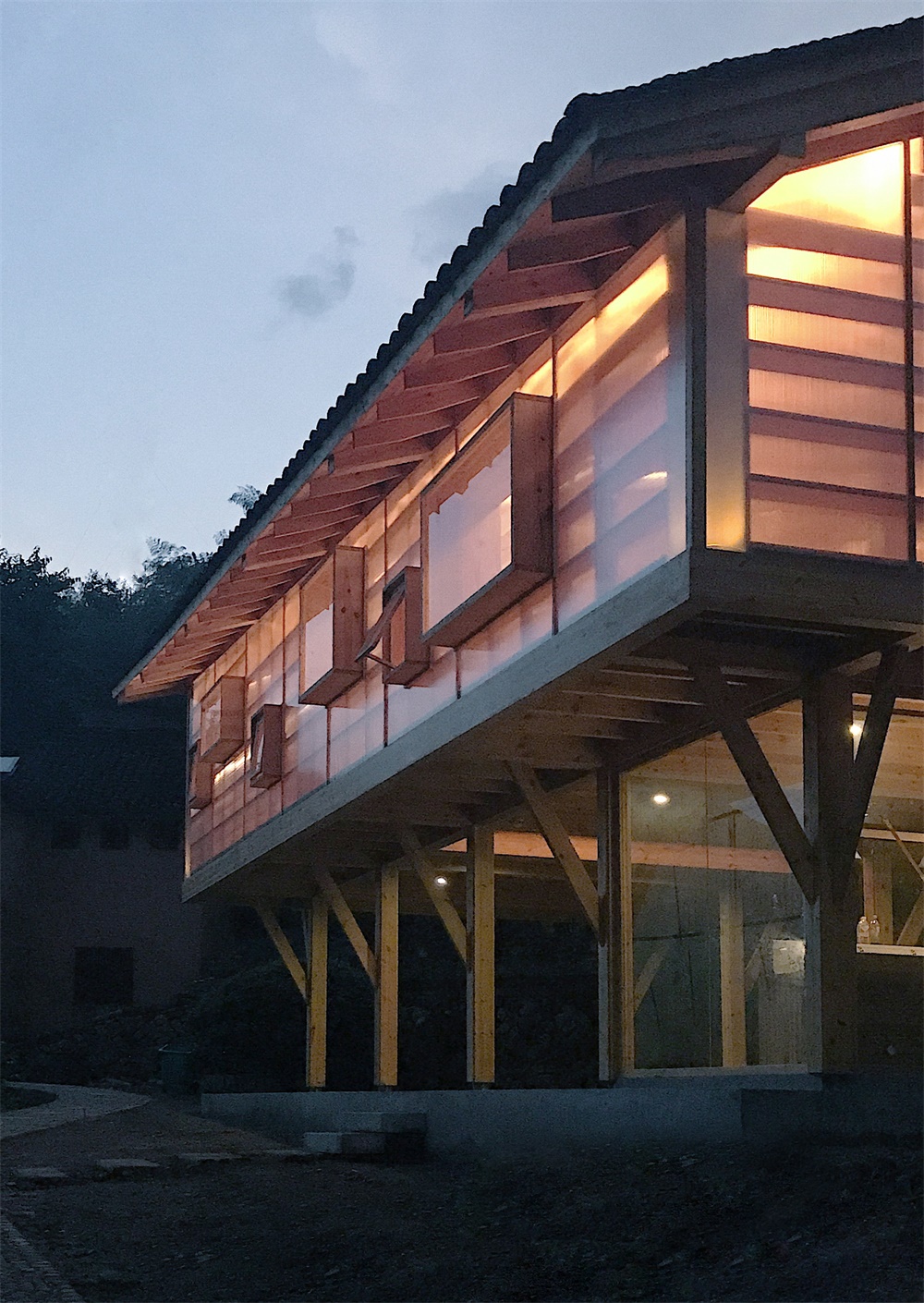
∇ 結構分解示意 Structural decomposition
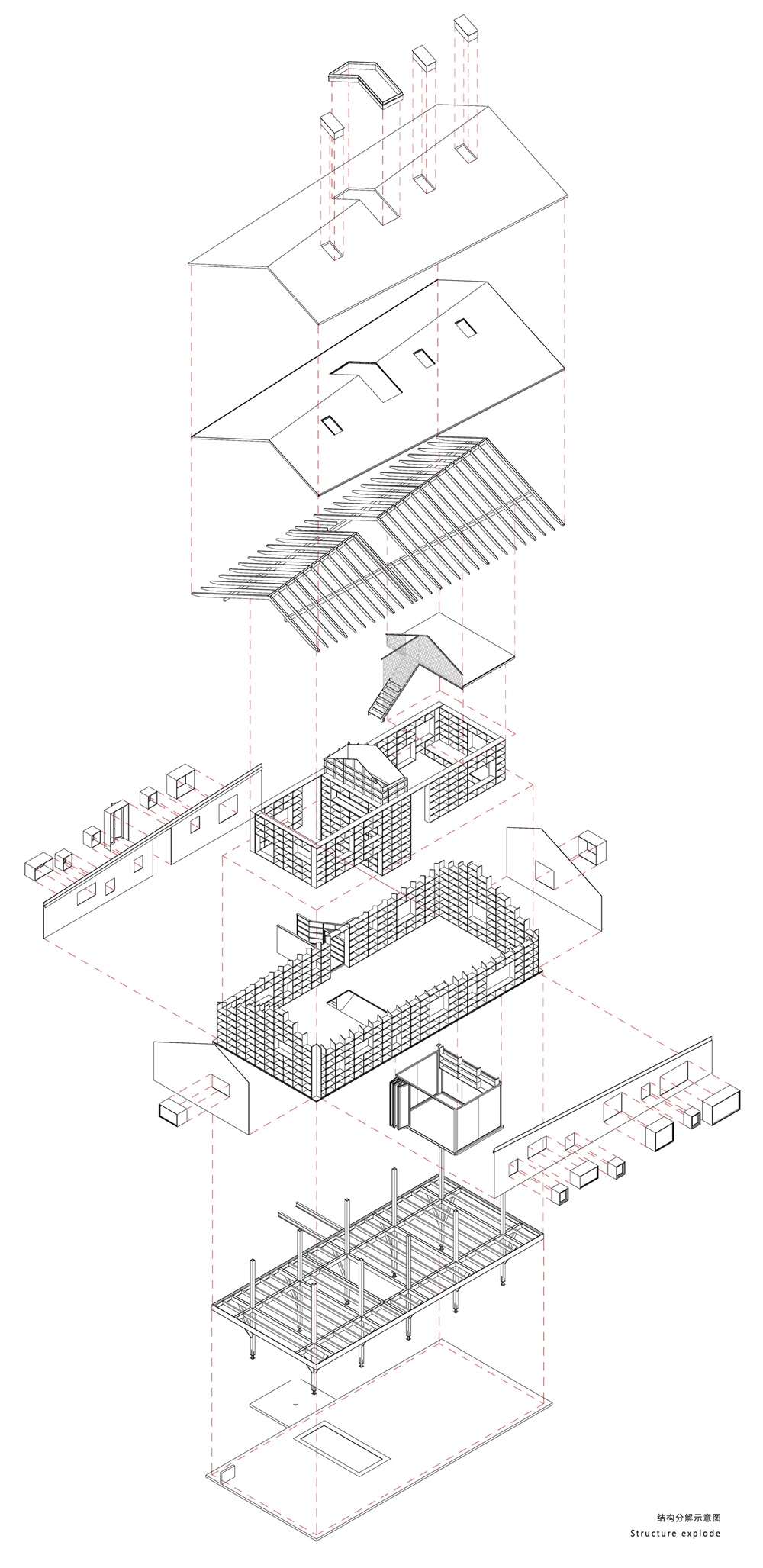
完整項目信息
項目名稱:武義梁家山·拾雲山房
項目地點:金華武義柳城鎮梁家山村
項目業主:宏福旅遊集團有限公司
項目類型:鄉村書屋
設計時間:2016.12-2017.8
建造時間:2017.10-2018.6
設計單位:尌林建築設計事務所
主持建築師:陳林
項目建築師:劉東英
參與建築師:劉東英、楊世強、簡雪蓮
結構形式:鋼木結構
建築材料:進口鬆木、陽光板、水磨石
建築麵積:156㎡
建築攝影:趙奕龍、陳林
Project information:
Project Name: Liangjia Mountain, Wuyi · Mountain House in Mist
Project Location: Liangjiashan Village, Liucheng Town, Wuyi, Jinhua
Project owner: Hongfu Tourism Group Co., Ltd.
Project Type: Countryside Book House
Design time: 2016.12-2017.8
Construction time: 2017.10-2018.6
Design unit: Shulin Architectural Design
Moderator: Chen Lin
Project Architect: Liu Dongying
Participating architects: Liu Dongying, Yang Shiqiang, Jian Xuelian
Structural form: Steel-wood structure
Building materials: Imported pine, sun board, terrazzo
Building area: 156㎡
Architectural Photography: Zhao Yilong, Chen Lin




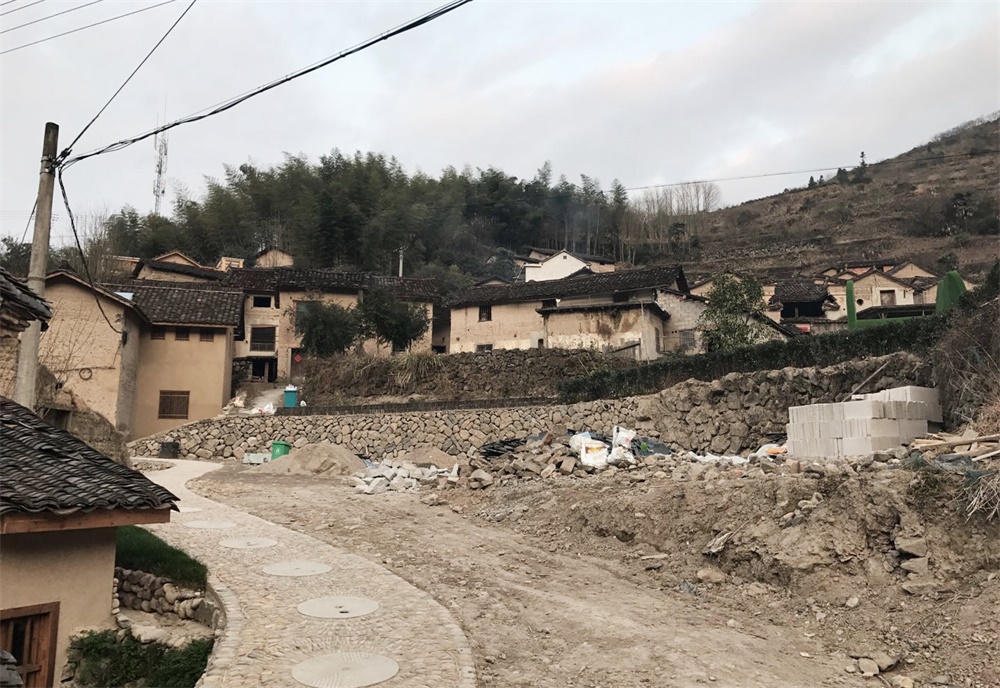




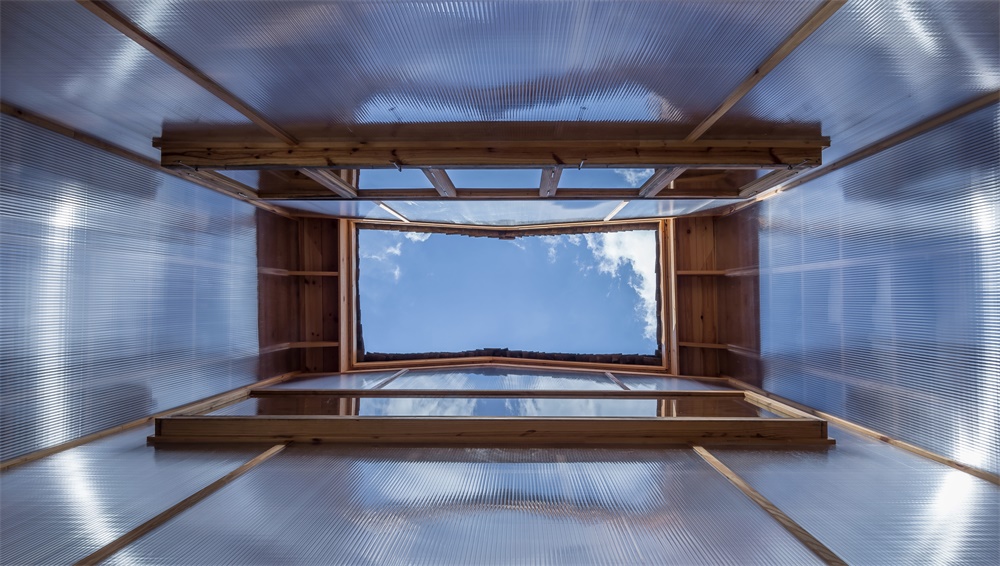





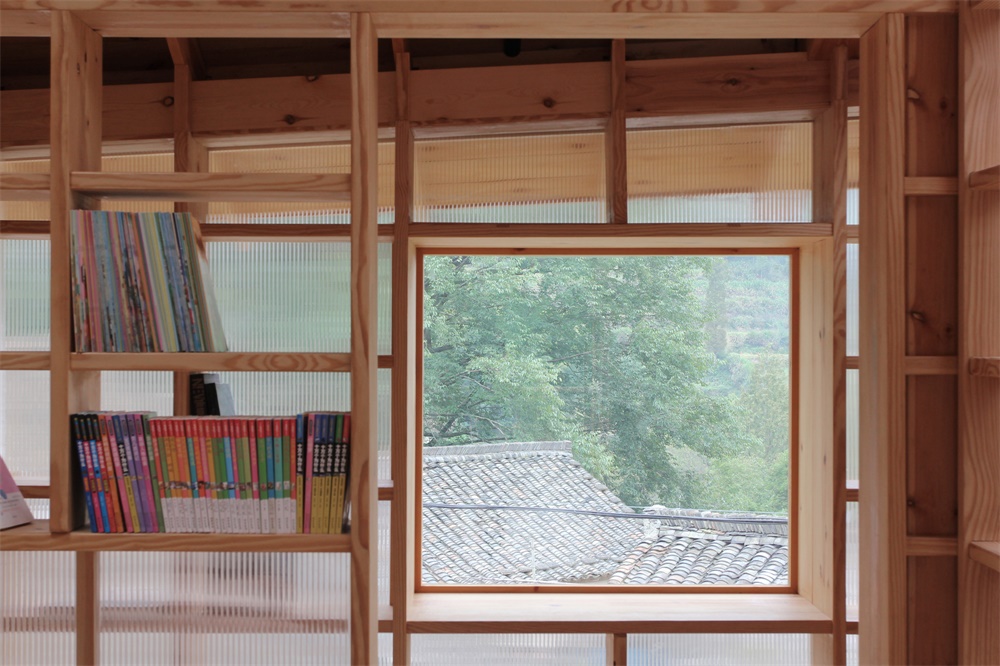
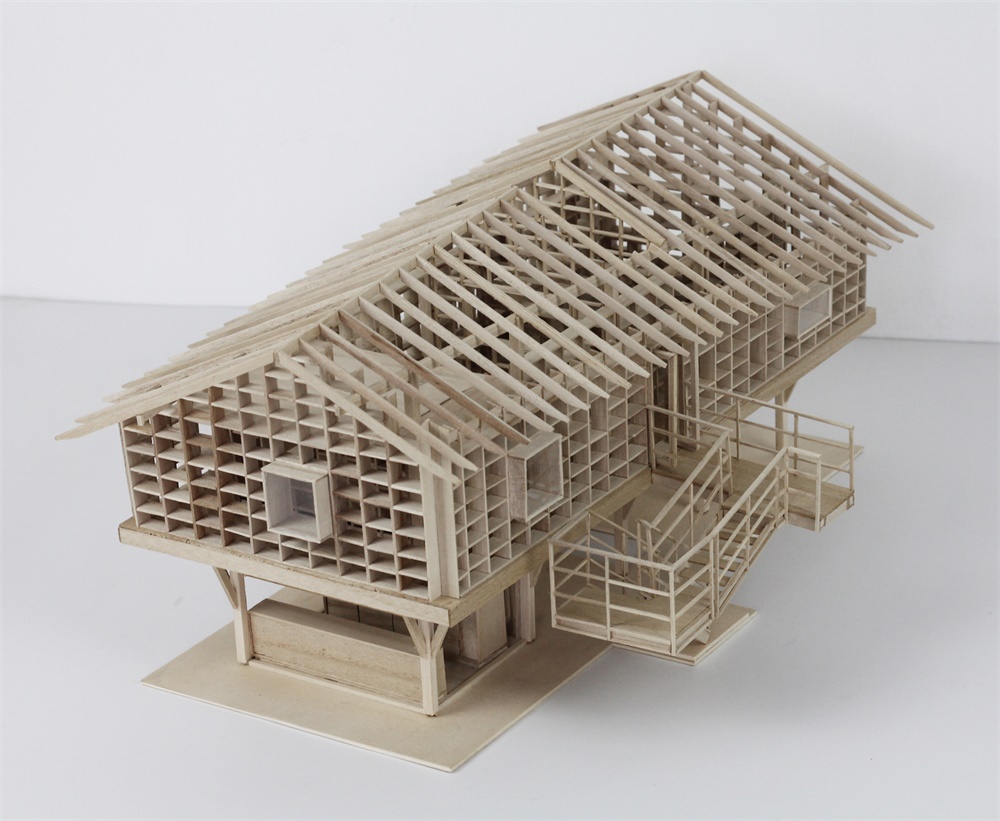



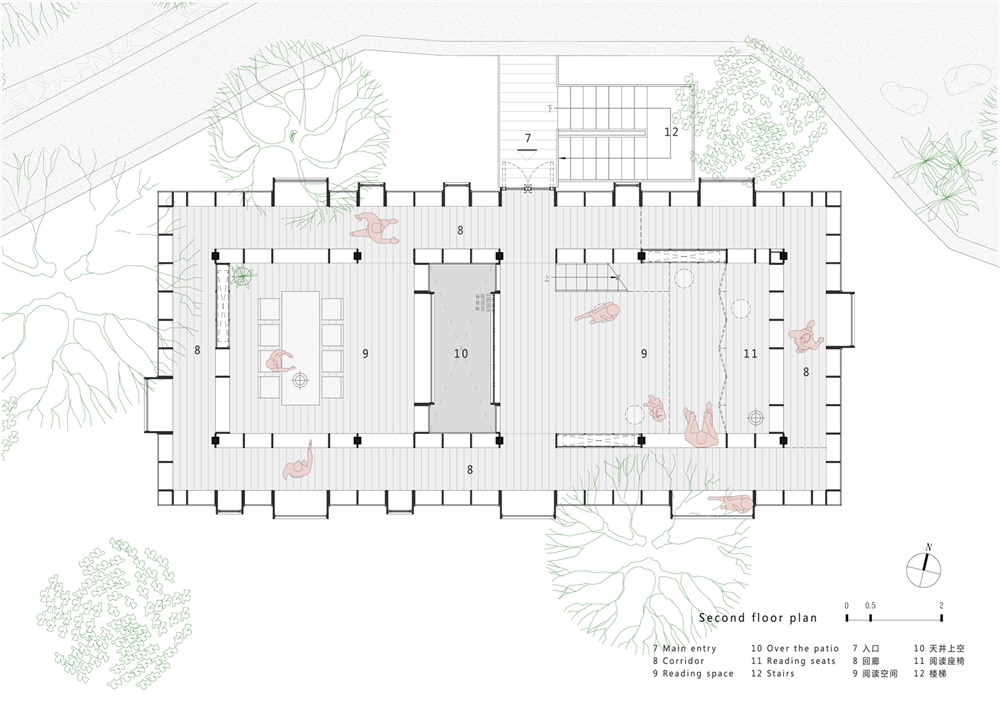


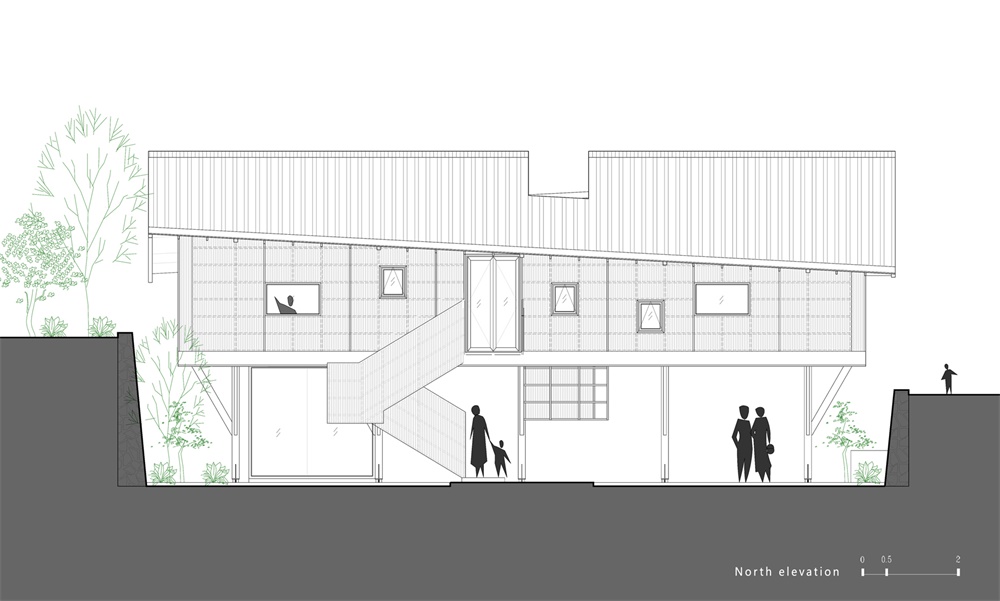









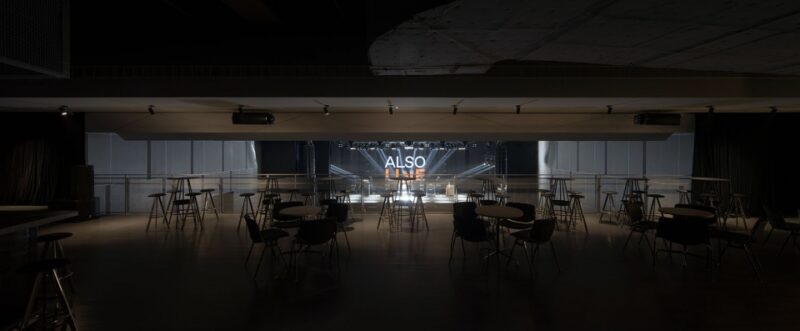




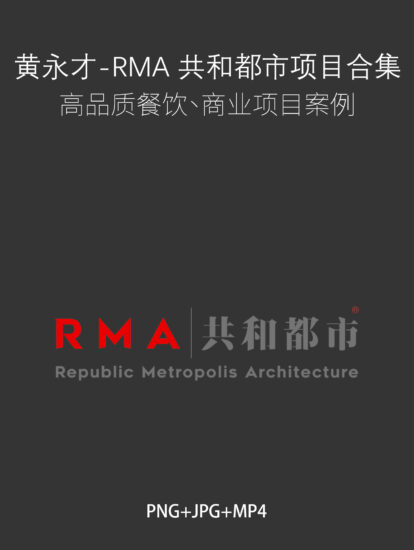



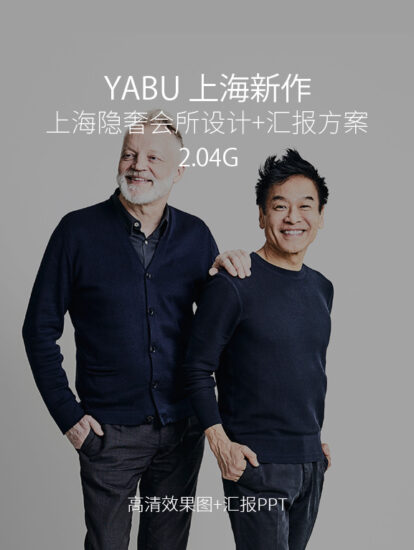
評論(1)
整體思路(包括空間價值的利用以及跟周圍環境的呼應)都很棒,但是有一個小問題,從內部體驗感來講大麵積時使用這種半透明的玻璃材質,會給人感覺很悶喘不上來氣的感覺,像置身於塑料大棚裏,所以我覺得如果在人視線範圍的高度采用全透明的玻璃窗更完美,更多的去考慮置身於建築物之內的人的感受。